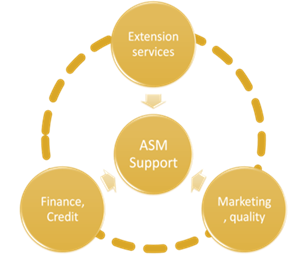
Zimbabwe ASM Profile Political Economy & Strategic Standpoints | Social and Environmental Factors | Local linkages | ASM Sites in Zimbabwe
Zimbabwe’s mining industry is focused on a diverse range of small to medium mining operations. The most important minerals produced by Zimbabwe include gold, asbestos, chromite, coal and base metals. The mining industry contributes approximately 8% towards the country’s GDP.
About 35 different metals and minerals are produced in Zimbabwe.The main minerals produced in Zimbabwe by order of contribution to exports are, platinum group elements, gold, diamonds, chrome (ferrochrome), coal and coal products, iron ore (steel), nickel, cooper, granite and graphite.
ASM in Zimbabwe has been producing significant amounts of gold which sometimes is seen to surpass large scale mining. In 2004, ASM produced 60% of the total gold produced in Zimbabwe (c. 29 tons); in 2005 the ASM sector produced 50% of the total gold production in Zimbabwe (21 tons). In the years between 2009 and 2013 the production from ASM has been declining mainly due to illicit trading.
Country Mining Vision Status
CMV Processes Underway.
Policies, Laws and Regulations Currently in Effect
Mines and Minerals Act, 1961
Main ASM Associations/Cooperatives
(Total of 53 registered and active associations)
I. WIM: Women in Mining
II. BSSMA Bubi Small Scale Miners Association
ASM Definition Criterion
None within any regulatory frameworks
ASM Licensing
Artisanal: NO
Small Scale Mining: YES
ASM Minerals or Metals Exploited
Precious Metals Gold and platinum group metals,
Base Metals Chrome, (ferrochrome), Copper, Iron Ore(steel), Nickel, Manganese, Tin, Lithium
Precious Stones Diamonds
Granite, dimension stones, limestone, aggregates, dolomites, graphite,
Mining Code Provisions for Women in ASM
There exists a Draft Mineral Policy of 2013 that is YET to be effected in any way whereby:
The shared vision will aim to achieve:
A sustainable and well-governed mining sector that effectively garners and deploys resource rents and that is safe, healthy, gender and ethnically inclusive, environmentally friendly, socially responsible and appreciated by surrounding communities;
Mineral Governance:
A new minerals regime will be configured to:
/ 5) Enhance the participation of indigenous Zimbabweans in mining and related linkage industries and facilitate equitable access to the sector by all Zimbabweans with the requisite capabilities, irrespective of gender or ethnicity.
Artisanal and Small-Scale Mining:
/Given the historical role of women in ASM, support systems to facilitate the entry of female entrepreneurs into this sector will be configured, such as a special window in the ASM VCF and customised short training courses under the Bulawayo School of Mines.
ASM SUPPORT TRIANGLE

The ASM support triangle may be seen as having been ideally showcased during times of ideal ASM production and processing support within Zimbabwe. The Shamva Mining Centre example was at times heralded as a reputable demonstration of how to start progressive support mechanisms for ASM production.
Finance and credit
The Government of Zimbabwe has, in the past, been funding the purchase or hire of processing plant equipment through a Mine Mechanization Fund. There is provision of extension services for technical assistance inclusive of mechanisms in place for market access of the mineral products produced in Zimbabwe. Notably, the Reserve Bank of Zimbabwe through an arm called Fidelity Printers, has the monopoly in purchasing of gold and silver produced in the country, and has recently instituted a “No Questions Asked” policy towards artisanal mined gold and through the Minerals Marketing Corporation of Zimbabwe (MMCZ) the government has been providing market channels for the mineral products.
Extension services - a phased approach to integration and capacity-building
Zimbabwe’s famed Shamva Mining Centre (SMC) was conceived as a multi-functional service provider to respond to the stated needs of the small-scale gold miners in the Shamva area of Zimbabwe. The design and implementation of the SMC was based on providing a service for about 40 ASM mine sites. The Centre's core function was to provide access, for small-scale gold miners, to efficient minerals processing. The centre also provides other services including tool hire (compressors) and advice on a range of subjects including geology, finance, mining, explosive and the environment.
The merit of this pioneer initiative was that after a few years, business people identified the mineral processing service provision as a viable economic (entrepreneurial) stream to indulge in, resulting in a proliferation of other vibrant Mining Centres (Service providers for ASM minerals processing) across the country.
Such was the commendable success of the SMC that other organizations that play a significant role in the technical training of miners, started working with and training miners in free mercury processing techniques which besides protecting the environment, also protect the miners themselves from mercury poisoning.
However, all the technical initiatives discussed above, can only be effective if there is structured and sustainable financial assistance to ASM Sector.
Marketing and quality
The ASM production especially that of any high value and low volume minerals, in most instances specifically gold and silver, is exclusively sold to the Fidelity Printers of Zimbabwe, a subsidiary of the Reserve Bank of Zimbabwe. While the other minerals, are sold to traders and brokers or even exported directly. The government offers a platform that links the producers and the market, the Minerals Market Corporate of Zimbabwe (MMCZ). The MMCZ charges a commission of 0.875% for each successful transaction.
In Zimbabwe, there are some initiatives on value addition of mineral products, especially the production of jewellery, pottery and stone caving. These products are sold domestically and exported to neighbouring countries such as South Africa, Mozambique, Botswana and Zambia.
The government banned the export of raw minerals in 2013. The Countries Agenda for Sustainable and Social Economic Transformation – Policy on Empowerment has resulted in the pulling out of most of the brokers who were geared towards the export of raw minerals. On the other hand, the country has been witnessing an increase in the number of small scale smelters for chromite, tantalite and manganese.

